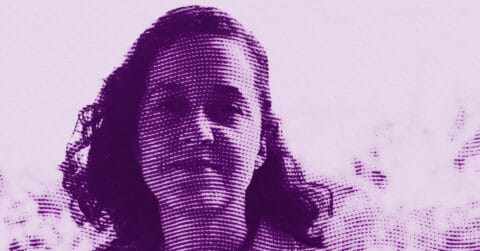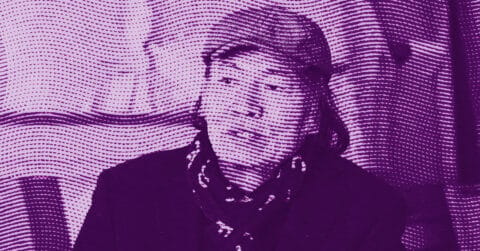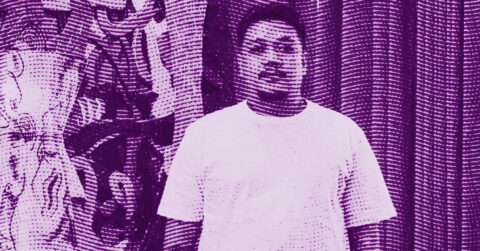Listen to me carefully, you bunch of snobs. Here is an artist who deserves to be paused for, looked at, and finally understood what it truly means to paint history in 2025. Lubaina Himid is not an artist like others. She is a cartographer of the invisible, a storyteller who reinvents the codes of representation to give form to those who were erased from official narratives.
Born in Zanzibar in 1954, emigrated to Great Britain at four months old, Himid carries within her this fundamental experience of displacement that flows through all her work. Graduated in theatrical design from Wimbledon College of Art in 1976, then holding a master’s degree in cultural history from the Royal College of Art in 1984, she develops a unique approach where scenography meets history painting. Because that is precisely what it is about: Himid reinvents history painting, this noble genre par excellence of Western art, to inscribe the forgotten figures of the African diaspora.
The architecture of collective memory
Her career as artist-curator in the 1980s reveals a keen awareness of representation issues. With exhibitions like “The Thin Black Line” at the Institute of Contemporary Arts in London in 1985, she does not merely show: she builds a space of visibility for British black women artists. This curatorial dimension of her work is not incidental; it structures her artistic thought as a true architectural project.
Architecture, indeed, constitutes the first conceptual thread that runs through Himid’s work. But it does not concern the monumental architecture of power buildings. No, Himid is interested in an architecture of intimacy and everyday life, the one that organizes living and survival spaces. Her installations such as “Naming the Money” (2004) transform the exhibition space into a theater of memory, where one hundred cut-out silhouettes embody Africans enslaved in the European courts of the 18th century. Each figure bears a name, an identity, a role: dog trainer, toy maker, cartographer, dance master, musician, painter. The artist restores a narrative architecture to these existences shattered by official History.
This architectural approach to memory finds its most accomplished expression in her recent “strategy paintings” exhibited in “Make Do and Mend” in 2024. These canvases depict black figures seated around tables, manipulating small objects representing resources, territories, entire populations. Architecture here becomes that of power: who has the right to sit at the table? Who remains standing? Who decides the fate of others? In “Bitter Battles” (2023), the lemons arranged on the table under different devices, cages, pedestals, and bare spaces reveal the invisible hierarchies that structure our societies. Himid thus dismantles the architecture of power to reveal its most pernicious mechanisms.
The domestic space also occupies a central place in this architectural reflection. Her recent paintings, such as the series “How May I Help You?” (2025), depict street vendors in their daily interactions with buyers. These seemingly trivial scenes actually reveal a complex geography of social relations, an invisible architecture of power relations exercised in public space. “I am absolutely obsessed with the daily act of buying and selling ordinary things,” the artist confides [1]. This obsession reveals a profound understanding of how social architecture unfolds in the simplest gestures.
The influence of her background in theatrical design is evident in this spatial approach. Himid conceives her exhibitions as stage settings where the viewer becomes an actor. The 2021 exhibition at Tate Modern was explicitly designed as “a sequence of scenes arranged to place visitors at center stage and behind the scenes” [2]. This dramaturgy of space reveals an architectural understanding of art as an immersive and transformative experience.
But architecture in Himid’s work is not limited to the organization of physical space. It also structures the temporality of her works. Her painted panels, these vertical formats reminiscent of musical measure bars, create a visual rhythm that organizes the exhibition space like a score. In the series “Aunties” (2023), sixty-four wooden panels found near her studio form a constellation of female presences that redefine the traditional gallery architecture. These “aunties,” tutelary figures from many non-European cultures, create a space of intimacy and protection at the heart of the artistic institution.
The floating territories of poetry
Another concept that permeates Himid’s work relates to poetry, not as a literary genre, but as a particular mode of relationship to language and image. Himid develops a visual poetics that proceeds by condensation, metaphor, and displacement, three fundamental operations of poetic writing applied to the plastic arts.
First, condensation. In her paintings, each element carries a maximum symbolic charge. The fabrics she incorporates into her paintings are never purely decorative: they carry with them family memories, textile traditions, cultural codes. “Patterns and clothing are important in my paintings. Dresses are a means for women to show their personalities to each other and to the viewer,” she explains about “Between the Two my Heart is Balanced” [3]. This poetic condensation transforms each textile fragment into a synecdoche of an entire culture.
Next, metaphor. Himid’s work operates through constant metaphorical shifts. In “The Carrot Piece,” the carrot brandished by a white man facing a black woman walking away becomes a metaphor for the false promises of recognition addressed to black artists. In the series “Le Rodeur” (2016), the slave ship metamorphoses into a space of resistance and creation. These metaphorical displacements reveal a poetic thought that rejects literality in favor of polysemy.
Finally, displacement. Himid constantly performs temporal displacements in her works. “The characters are not always in the same temporal or historical zone,” she specifies. “They cross paths through time and speak to each other (and to you) about how the past contains clues for the present, and is a place of potential action” [4]. This floating temporality characterizes the poetic thought that rejects linear chronology in favor of a stratified temporality.
This poetic approach finds its most refined expression in her collaboration with Magda Stawarska, her partner and artistic collaborator. Their installation “Slightly Bitter” (2025) at Kettle’s Yard explores the fragmentary correspondence between writer Sophie Brzeska and artist Nina Hamnett in the early 20th century. This work proceeds by poetic montage, assembling sounds, paintings, found objects, and postcards to resurrect a relationship erased by History. “This installation is not a documentary, it is about conversations, translations, and exchanges,” Himid specifies. This poetics of trace and fragment reveals a deeply modern sensitivity to the discontinuity of historical experience.
The sound dimension of this collaboration with Stawarska greatly enriches Himid’s visual poetics. Stawarska’s sound compositions do not function as mere accompaniment but as a poetic counterpoint to the painted images. In “Naming the Money,” the voices pronouncing the African and European names of the depicted figures create a memorial polyphony that multiplies the emotional charge of the installation. This synergy between sound and image reveals a poetic understanding of art as total art.
Himid’s poetics is also nourished by her fascination with everyday objects transfigured by painting. Her painted ceramics from the series “Swallow Hard: the Lancaster Dinner Service” (2007) transform domestic tableware into a medium of historical memory. These plates adorned with patterns evoking the slave trade subvert the decorative function of porcelain to make it a critical medium. This poetics of transfiguration reveals a particular sensitivity to the magical dimension of art.
Himid’s use of color also belongs to a particular poetics. Her bright yellows, deep reds, and intense blues do not aim for plausibility but for expressive intensity. As critic Fred Moten noted, her “celebration of color” becomes “the ultimate solemnity.” This chromatic poetics transforms painting into a song of resistance and affirmation.
The strategy of the visible
Himid’s recent work reveals a remarkable artistic maturity in her ability to synthesize these different approaches. Her “strategy paintings” of 2023 constitute in this regard a culmination of her reflection on the relationships between power, representation, and resistance. These canvases depict scenes of negotiation where Black figures manipulate symbolic objects on tables. The architecture of these compositions, the arrangement of bodies in space, the geometry of the tables, and the distribution of objects reveal the invisible mechanisms of political and economic power.
In “Predicting Positions” (2023), the models arranged on the table evoke solar systems, an ironic allusion to the colonial ambitions of some of our contemporary oligarchs. This work constitutes a particularly sharp critique of the ruling class and its tendency to dehumanize those it governs. Himid poses a fundamental question: what do we lose when we accept being reduced to manipulable data on a strategist’s table?
The series “Aunties” (2023) reveals another facet of this artistic maturity. These sixty-four painted boards transform the exhibition space into an assembly of tutelary figures. Each “aunt” has her uniqueness, textures of found wood, colorful fabrics, and painted patterns, while participating in a coherent whole. This work accomplishes the feat of reconciling individuality and collectivity, singularity and community.
The late but brilliant recognition of her work, Turner Prize in 2017, Commander of the Order of the British Empire (CBE) in 2018, exhibition at Tate Modern in 2021, and representation of Great Britain at the Venice Biennale in 2026, should not obscure the persistence of her critical approach. At more than seventy years old, Himid continues to question power relations with the same acuity as at the beginning. “We missed an opportunity,” she confides about the 1980s and 1990s. “We set ourselves the goal of showing our work to as many people as possible. But we did not think about selling it. It never crossed our minds” [5].
This critical lucidity on the mechanisms of the art market reveals an artist who has lost none of her political analytical capacity. Her installation for the Venice Biennale 2026 promises to be a defining moment to measure the relevance of her message in the contemporary geopolitical context.
Himid’s growing influence on new generations of artists testifies to the accuracy of her vision. Her ability to combine political commitment and aesthetic excellence offers a rare model in the contemporary artistic landscape. She demonstrates that it is possible to deliver a strong political message without sacrificing formal and conceptual complexity.
Her relationship to Preston, where she has lived since 1991, also reveals a territorial dimension of her commitment. “It’s a small town, but it works for us,” she explains. This local anchoring of her practice, far from London’s artistic centers, reflects a desire for decentralization that corresponds to her overall aesthetic approach.
Lubaina Himid’s work constitutes one of the most significant contributions to British contemporary art of the past forty years. She manages to reconcile formal innovation and political commitment, aesthetic research and historical awareness. Her paintings, installations, and collaborations reveal an artist constantly capable of reinventing her visual language to question the issues of her time.
Her ability to maintain a high formal standard while conveying a radical political message makes her a unique figure in the international artistic scene. The architecture of her installations and the poetics of her paintings open unexplored territories for contemporary representation. Himid reminds us that art is never neutral; it always participates in the construction of the world in which we live. By giving form to the invisibles of History, she contributes to building a fairer and more humane world. It is in this that her work far exceeds the artistic frame to address the most urgent political and ethical issues of our time.
- Wallpaper, “Lubaina Himid and Magda Stawarska’s new show at Kettle’s Yard will uncover the missing narratives in everyday life stories”, June 2025
- Tate Modern, “Lubaina Himid”, exhibition catalogue, November 2021
- Tate Kids, “Who is Lubaina Himid?”, 2021
- Greene Naftali Gallery, “Lubaina Himid”, artist biography, 2024
- The Guardian, “Artist Lubaina Himid: ‘The YBAs were wired into selling art. We had no idea that was how to do it'”, March 2025
















